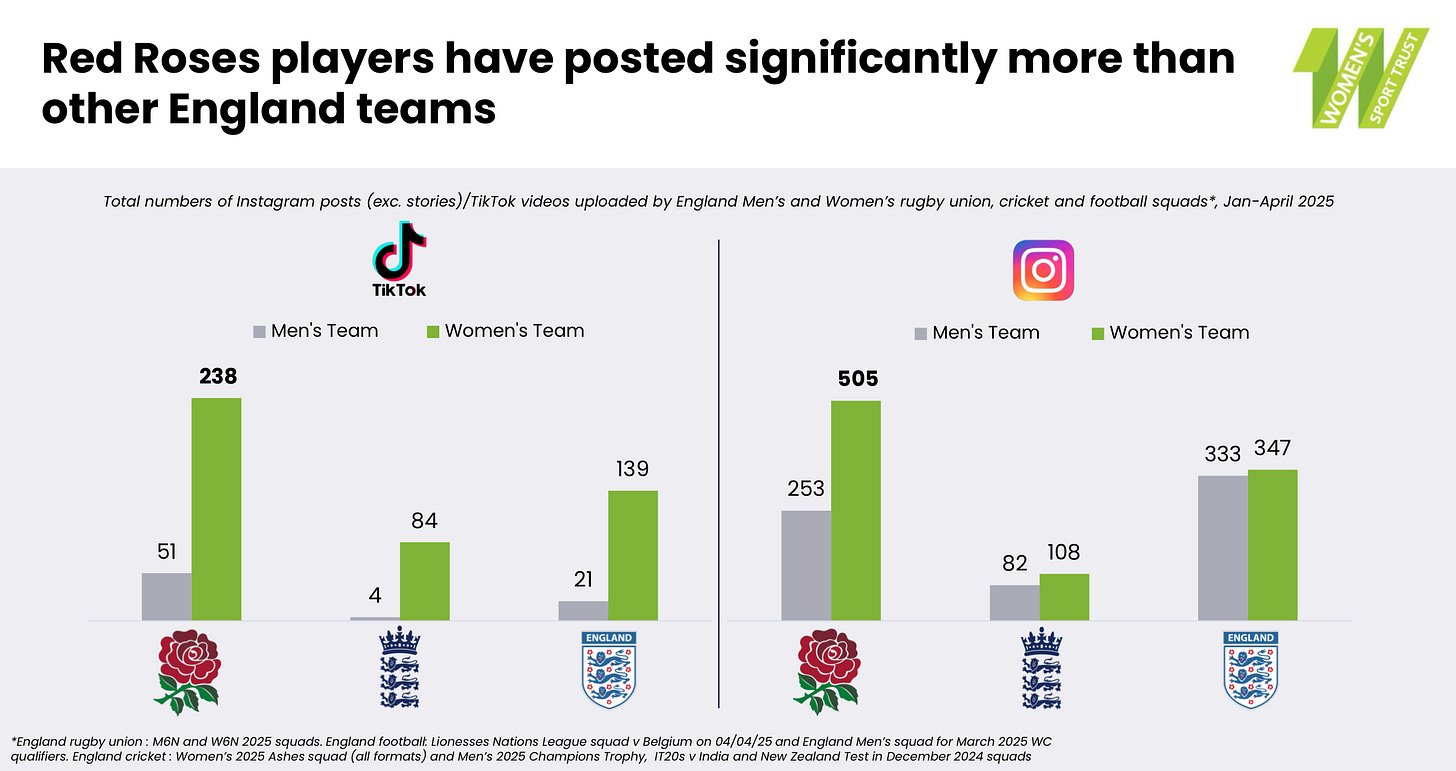Attendances down, TV viewing figures falling, but TikTok and Instagram metrics up. This is the current state of engagement with women’s professional sport in the UK. Phone surfing can be monetised, but there is an urgent need to turn scrolling followers into ticket buyers and paying subscribers.
It should be no surprise - nor is it any disgrace - that the rapid growth in interest in women’s sport has relatively shallow foundations. The UEFA Women’s Euros, the upcoming Rugby Women’s World Cup and next year’s women’s T20 World Cup will doubtless prompt renewed surges in casual followers. These must be seized as opportunities to reinforce those foundations, to build durable supporter bases. If blinded by dazzling social media statistics, the current underlying fragility will persist.
The Women’s Sport Trust last week published an in-depth study on the visibility of women’s sport. It shows TV coverage of women’s sport fell by 15% in the first five months of 2025 after a 20% drop in the previous comparable period. Overall ‘reach’ (unique views of three minutes or more) slid by 13%.
The declines were steeper on pay TV than free-to-air - a sign perhaps that subscription broadcasters are making hard-nosed decisions based on viewing figures. Women’s Super League matches on Sky attracted an average of 69k viewers, a 41% year-on-year decline. EFL games, by contrast, had 165k viewers (down 21%), Premier League matches 835k (up 8%). And it’s not just sofa fans. WSL crowds fell 10% to an average 6,661, in spite of more matches being staged in Premier League stadia.
The Trust does not shy away from these stats, but does go big on the surge in social media activity and followership in women’s professional sport. For example, the overall digital engagement with the WSL on Sky Sports’ platforms jumped by a third year-on-year, a stark contrast to its TV viewing figures.
Women’s sport has built much of its current visibility on the celebrity of its stars. The Lionesses, who start the defence of the Euros trophy on Saturday, are a prime case. The promotion of their off field activity has created abundant followers but not necessarily conventional fans - those wanting to pay to go through turnstiles or whose viewing habits justify monthly pay TV subscriptions. As the Women’s Sport Trust acknowledges, the challenge is conversion of casual digital fandom into something more durable and valuable.
For now, the scale of followership of women’s sport gives it the opportunity to broaden and deeper its talent pool, to ensure that competition becomes stronger and more unpredictable. International football has achieved the necessary scale, but success in the domestic game is concentrated within too few teams.
Both women’s cricket and rugby suffer internationally from financial imbalances. The Red Roses only ran into close competition in their last Six Nations match this season against France. They are one of maybe three teams with a serious chance of winning this autumn’s World Cup. In cricket, Australia and India are currently dominant nations, although England’s women have no excuse for not being currently ranked alongside them. Both sports need to find ways to nurture talent - and hence competitiveness - across a broader pool of nations.
Finance as ever is the key. Football has pump-primed the growth of the women’s game, but the reluctance of a slew of Premier League owners to compete with the four clubs at the top of the WSL is a clear reminder that there is no magic money tree and that in the long run investment will only be sustained if paying fanbases grow.
Women’s sports are often judged using the yardsticks typically applied to their male counterparts. While understandable, this is not necessarily fair. Women’s sport should continue to explore its own routes to sustainability. There will come a point though at which money will prove the ultimate determinant. Another year or two of social media growth masking declining core fandom and the shallow foundations could crumble. Those mega tournaments could not have come round at a more opportune time.
Laugh Kookaburra, laugh Kookaburra!
A four motorway schlep for my first ever visit to Canterbury for day three of Kent’s game against Northants. (Embarrassing that I’d not been before really, as by birth I am a Kentish Man). This was one of the matches in the current County Championship batch played with the Kookaburra ball rather than the Dukes one traditionally used in England.
The ECB is hoping to harden English bowlers for overseas duty, where the Kookaburra is deployed. The result so far has been run-fests, drawn games and drained seamers.
The first two days of the nine matches in this latest Championship round produced a total 6,116 runs for 121 wickets. That’s an averages of 50 runs per wicket and just 6.7 wickets a day. Surrey racked up 820-9 declared in their first innings against Durham. Three other sides scored over 500.
Down in Canterbury I saw Northants relentlessly add 483 runs, losing just 5 wickets in the process. No sporting fireworks though.
Highlight was an impromptu visit to the Spitfire Ground’s huge mechanical scoreboard, a rarity in the modern world of digital screens. A reminder too of the need to cherish heritage as English cricket’s rulers tinker with the sport’s structure.
The protracted negotiations about the shape of the English cricket calendar are said to be nearing a conclusion. Most rumoured outcomes entail a reduction in County Championship fixtures. If the competition is to be regarded as anything more than a feeder for the England red-ball team, then surely any lessons learned from the Kookaburra experiment must be documented and these Australian balls then confined in future to the ECB’s Performance Centre at Loughborough.
STOP PRESS: only three of this week’s nine Championship matches produced positive results. I doff my floppy white hat to the three bowling cohorts that each conjured up twenty wickets in such adverse conditions.
Strange brew
My drive to the Spitfire Ground was enlivened by a few episodes from the various pod series on Sport’s Strangest Crimes, as flagged to me by a Sport inc. reader who got in touch after reading last week’s piece on Fixed. Moses Swaibu’s football match fixing makes up one of the series. Others dig into Bloodgate, Shergar, Spygate, Allen Stanford and more. Well worth a leisurely listen on BBC Sounds







The headline of the BBC report on the match read something along the lines, ‘Kent hang on for a thrilling draw’! Perhaps we should be thankful the Kookaburra was used.